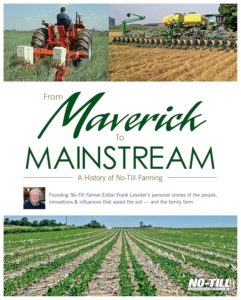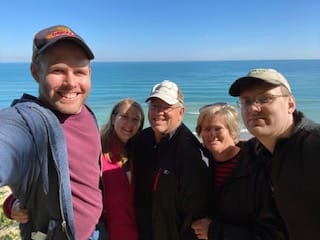Review of Frank Lessiter’s “From Maverick to Mainstream: A History of No-Till Farming”
What would be the feeling of this nation should a foreign nation suddenly enter the U.S. and destroy 90,000 acres of land, as erosion is allowed to do in a single country?”
– Hugh Hammond Bennett, viewed as the father of soil conservation, 1881-1960
 Getting rid of the plow and quitting cultivating is the theme of the book “From Maverick to Mainstream: A History of No-Till Farming” by Frank Lessiter. In 400-plus pages, this tabletop book explores the history of no-till farming through a collection of articles from No-Till Farmer magazine, which has been in print since 1972, and many personal stories from and about the people and inventions that have influenced no-till farming.
Getting rid of the plow and quitting cultivating is the theme of the book “From Maverick to Mainstream: A History of No-Till Farming” by Frank Lessiter. In 400-plus pages, this tabletop book explores the history of no-till farming through a collection of articles from No-Till Farmer magazine, which has been in print since 1972, and many personal stories from and about the people and inventions that have influenced no-till farming.
The book begins with stories of farmers starting to question the effectiveness of the moldboard plow for preparing the seedbed. The plow was linked with the devastating effects of the Dust Bowl on soil, farms and livelihoods during the 1930s. It was around this time that people started questioning the myth that wind and soil erosion are the major causes of soil degradation. In fact, tillage is the main culprit – and that’s how no-tillage was defined: as getting rid of the plow and quitting cultivating.
Readers learn about Hugh Hammond Bennett’s pioneering work on soil erosion, and that much of the early no-till work was based on Edward Faulkner’s revolutionary book “Plowman’s Folly,” published in 1943. In it, Edward stated, “No one has ever advanced a scientific reason for plowing.” His book questioned the widely accepted orthodoxy of moldboard plowing, and in 1956, the federal Soil Bank Program – the predecessor of today’s Conservation Reserve Program – started paying farmers to quit farming marginal lands.
In 1966, equipment manufacturers, such as Allis Chalmers, successfully commercialized a no-till planter. But acceptance of no-tillage was slow to take off. Even as chemical companies began developing herbicides to make no-tillage practical, no-till was considered “farming dirty.”
One article from 1972 that Frank includes highlights this gap while painting a sharp contrast between the benefits of switching to no-till versus relying on other conservation practices alone. It tells how an Indiana Soil Conservation worker stated that, given current no-till adoption rates in his area at that time, it would take 118 years to control erosion with strip cropping, terraces and other conservation practices compared with using no-till for just one year.
Elsewhere in the book, we learn that engineers of planter equipment were questioning the need to turn over anywhere from 500 to 1,000 tons of soil per acre with the plow when we only need 8% of the ground for a seedbed.
Over time, however, no-till started catching on. Rapid expansion of precision technology has helped no-tillers cut fertilizer and seed costs, improve crop stands and reduce their environmental footprint. Frank’s readers learn how acceptance of no-till spread in the U.S. and other countries. Machinery dealers abroad, for instance, have been quick to encourage farmers to use no-till equipment.
And we can’t forget the “underground critters” – the worms, fungi, bacteria and organic matter. The book references university studies showing how earthworm populations increase in no-tilled fields compared with other tillage methods.
By the end of “From Maverick to Mainstream,” readers will have a better sense of the history no-tillage and the people who were key to advancing this innovation. Even experienced or long-time no-tillers will get a behind-the-scenes look at the hurdles no-tillage faced, and its wins. Everyone will come away reminded of this fundamental truth: Everything starts with the soil.
Book reviewed by Laura Foell
Laura Foell was raised on a small farm in southern Illinois on which her family raised livestock and crops. She graduated from Southern Illinois University at Carbondale, Illinois, with a degree in general agriculture in an era when only one of five of students was female. After marriage, she moved to Iowa in 1984 to join her husband on his family farm in Sac County.
She and her husband own, farm and co-manage the family farm and have been no-tilling for more than 30 years. They have developed farm plans including buffer strips, CRP, strip tillage and horticulture crops in addition to corn and soybeans.
Recently, their son Tom has joined the operation as they continue the century farm for another generation. In the spirit of transition planning, they hold yearly family planning meetings in which their son, daughter and son-in-law participate and to make sure the next generation is prepared to assume responsibility.

